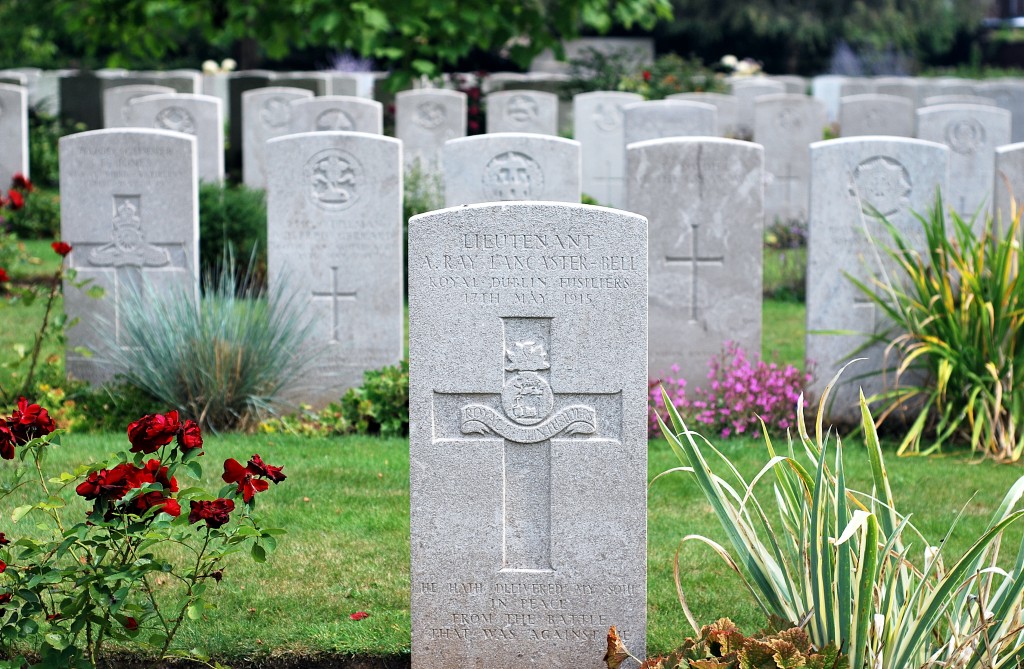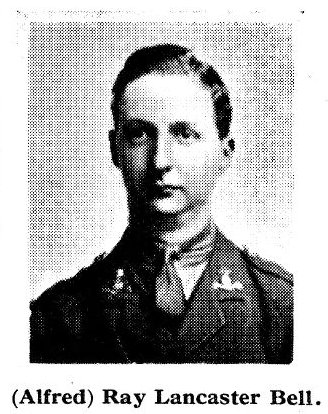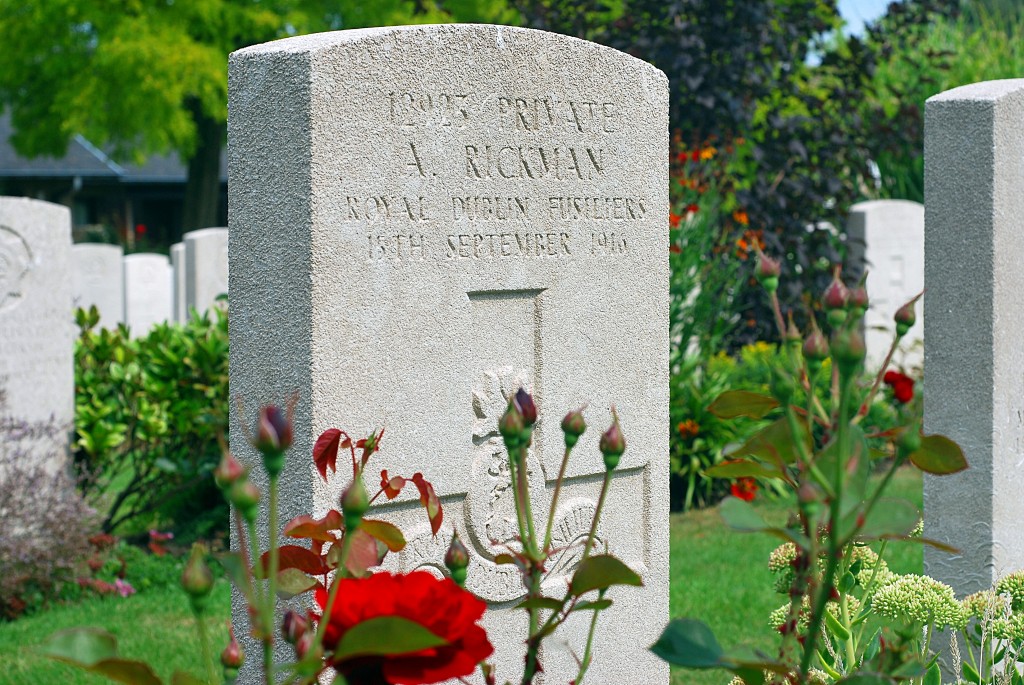This cemetery is located less than 10 minutes drive west of Ypres (Ieper) town centre. It is quite a large cemetery containing over 1000 burials but just five of these are members of the Royal Dublin Fusiliers. The cemetery was originally begun by French troops shortly after the start of the war but was quickly taken over by British forces who used it from April 1915 until June 1917. Three of the five Dublin Fusiliers burials here date from the first few months of the British use of the cemetery. Located behind the British lines at Ypres many of the men who are buried here died of wounds received in action. One of these is Lieutenant Alfred Ray Lancaster-Bell of the 2nd Battalion who was aged 19 when he died in 1915 and his story is an example of the sometimes extremely short life expectancy of men newly arrived in the trenches. The only child of Alfred and Annie Bell of Morehampton Road, Dublin he was born in Ballinasloe in February 1896. He was educated in Dublin and was commissioned shortly after the outbreak of war. He was attached to the 2nd Battalion of the regiment for service on the Western Front and arrived in the firing line with his regiment on 15 May 1915. Just two days later he was wounded by shrapnel in the lung and was evacuated from the trenches to the 12th Field Ambulance at Vlamertinghe where he died four hours later. He was then buried in what is now Plot 1 Row E of the cemetery.

The grave of Lieutenant Lancaster-Bell at Vlamertinghe

Another grave of note in this cemetery is that of Private Albert Rickman of the 1st Battalion Dublin Fusiliers in Plot 4 Row D. Rickman who was aged 27 when he was executed on 18 September 1916 for desertion. The son of Charles and Anne Rickman he was born at Milford-on-Sea, Hampshire in 1889. He had joined the 7th Battalion of the Dublin Fusiliers and originally served during the campaign in Gallipoli where he was wounded in September 1915, but was later transferred to the 1st Battalion now serving on the Western Front and arrived in France by March 1916. Rickman took part in the first day of the Battle of the Somme and he advanced with his battalion at 8am in the second wave attacking towards Hawthorn Ridge near Beaumont Hamel. The whole battalion was confronted by very heavy machine gun fire and the battalion war diary described the problems facing the battalion,
“our own barbed wire was only cut at intervals of about forty yards and by this time the Germans had machine guns trained on these gaps, the result being that our casualties were very heavy and only a few of our men ever got through the wire and and still fewer of these succeeded in advancing more than fifty or sixty yards before being shot down.”
By the end of the 1st of July, casualties in the battalion were estimated at over 200. Rickman was noticed to be absent from his battalion the following day. 18 days later was apprehended by the Military Foot Police at Abbeville, a town on the French coast and over 70 kilometres from where he went missing at Beaumont Hamel. A few months later he was placed on trial for desertion, found guilty and sentenced to death. At 6.10 am on the 15th of September 1916. eight days after his trial had begun, Albert Rickman was executed by firing squad his body being buried in the cemetery at Vlamertinghe.

The grave of Albert Rickman, one of two Dublin Fusiliers executed by British authorities during the First World War
[google-map-v3 width=”350″ height=”350″ zoom=”12″ maptype=”roadmap” mapalign=”center” directionhint=”false” language=”en” poweredby=”false” maptypecontrol=”true” pancontrol=”true” zoomcontrol=”true” scalecontrol=”true” streetviewcontrol=”true” scrollwheelcontrol=”false” draggable=”true” tiltfourtyfive=”false” addmarkermashupbubble=”false” addmarkermashupbubble=”false” addmarkerlist=”50.8557,2.82004{}4-default.png{}Vlamertinghe Military Cemetery” bubbleautopan=”true” showbike=”false” showtraffic=”false” showpanoramio=”false”]
Cemetery Location




